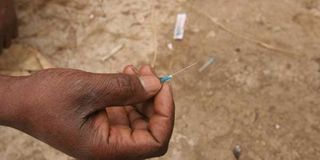Coast records decrease in sharing of needles and syringes among drug users

Following the successful implementation of the needles and syringes programme in Mombasa, most drug users in the county are no longer sharing needles. FILE PHOTO | NATION MEDIA GROUP
What you need to know:
- Thousands of youth are still taking drugs and other IDUs may still be sharing syringes due to inadequate funds for the prevention programmes.
- Nascop Coast region field officer Janet Musimbi said that 80 per cent of injecting drug users do not know their HIV status.
- Majority of the IDUs were willing to change, with 52 per cent of them found to be going to a rehabilitation centre for treatment.
- Mr Basheeib added that support for the programme which began in the 2012, was crucial in reducing the spread of HIV among drug users.
At least 1,000 injecting drug users (IDUs) in Mombasa County no longer share needles and syringes following successful implementation of the needles and syringes programme.
This was revealed by Taib Basheeib, the director of Reach out Centre Trust (RCT).
He was speaking during a stakeholder’s consultative meeting organised by the National Aids Control Council (Nacc) at the county commissioner’s boardroom Tuesday.
But the meeting also heard that thousands of youth are still taking drugs and other IDUs may still be sharing syringes as a result of inadequate funds to finance the prevention programmes.
“We have seen a reduction in the number of drug users who earlier picked syringes from dumpsites and spoiled incinerators.
“We have reached over 1,000 users under the programme yet there are many others whom we have not reached in areas such as Mariakani and Jomvu where we also have hotspots due to inadequate financing,” said Mr Basheeib.
He noted that there are over 100 drug hotspots in the county each with drug users ranging from 200 to 300 in number.
National Aids and STI Control programme (Nascop) Coast region field officer Janet Musimbi said that 80 per cent of injecting drug users do not know their HIV status.
HIV INFECTIONS
Ms Musimbi said that 17 per cent of new HIV infections come from this population with women between the ages of 15 to 49 years constituting 8.8 per cent.
She said that before the needles and syringes programme, drug users would share needles amongst themselves resulting to the spread of HIV.
“Initially we used to have a lot of sharing practices amongst IDUs.
“In Mombasa for instance 95 per cent of them had injected heroine or other narcotic drugs,” she said.
This she said, was according to a survey done in the 2013/2014.
She added when it came to using a new needle, 88 per cent of the 95 per cent of drug users who had injected themselves said that they had used a new needle when injecting themselves drugs.
The Nascop official added that they also found out that, majority of the IDUs were also willing to change, with 52 per cent of them found to be going to a rehabilitation centre for treatment.
Mombasa People Living with Aids Support Network (Mopesun) member Lois Tumbo said fighting HIV among drug users who are infected is hampered by inadequate viral load machine at the Coast General Hospital to assist patients in testing and tracking their treatment progress.
“We only have one viral load machine at the hospital and few staff are trained on how to use the machine yet we have more than 58,000 people living with HIV in Mombasa,” she said.
Mr Basheeib added that support for the programme which began in the 2012, was crucial in reducing the spread of HIV among drug users especially at a time when youth aged 12 years are engaging in the practice.





